John Constable( 1776-1837 ) was an English Romantic painter. Born in Suffolk, he is known principally for his landscape paintings of Dedham Vale, the area surrounding his home-now known as “Constable Country”-which he invested with an intensity of affection. “I should paint my own places best”, he wrote to his friend John Fisher in 1821, “painting is but another word for feeling”. Although his paintings are now among the most popular and valuable in British art, he was never financially successful and did not become a member of the establishment until he was elected to the Royal Academy at the age of fifty-two. He sold more paintings in France than in his native England.
“It must not be imagined, however, that his art lacked all encouragement during his lifetime. The little band of his admirers constantly received new adherents, and many of his pictures found purchasers, though a number of them remained in his possession until the end. In France his success was immediate, and his art had great influence on a number of the younger landscape painters. When his pictures were first exhibited in the Louvre in 1824, the revolt against classicism was just beginning—a classicism more severe and more widely spread than in England, where Wilson and Gainsborough had laid the foundations of a real school of native landscape in the previous century, and where such men as Turner, Girtin, Cozens, and the early water-colourists were already at work —men whose early training had been on traditional lines, but whose practice was based upon a sincere study of Nature, resulting in the gradual throwing off of the useless fetters which only hampered their progress. In France the influence of David still reigned supreme, so that Constable’s fresh, realistic painting came as a revelation, and was felt more vividly, and had more immediate effect, than in England. Here the true appreciation of the vital qualities of his art grew more slowly, and was far from universal for many years after his death.
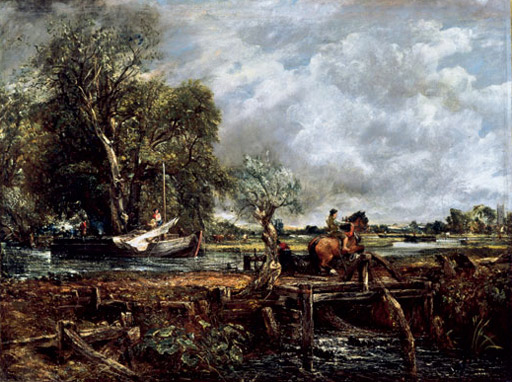
In describing the painting to a prospective buyer Constable wrote: ‘Scene in Suffolk – banks of a Navigable River – barge Horse leaping on an old Bridge. Under which is a flood Gate and an Eli bray. River plants and weeds – a more-hen frightened from her nest – near by in the meadows is the fine Gothic tower of Dedham’. ‘Eli bray’ is probably local vernacular for an eel-trap. A net can be seen trailing in the sluice under the bridge, almost certainly intended to trap eels.
Constable almost always had difficulty in selling his work.He had a volatile personality, no innate sense of marketing or sales charm, and could be aggressively pig headed at the wrong moment. In his six “canal” pictures of 1819-1825, Constable combined his inspired vision of landscape with, he hoped, sufficient traditional feeling to make the canvases acceptable to the public, and partcularly to the artists at the Royal Academy. Nothing doing. The work was panned, and this criticism almost took on the form and tone of religious puritanism; his brush strokes were irritating, his colors were poorly blended, he lacked drawing skills etc.
“These qualities of his art, this perpetual seeking after freshness, even at the sacrifice of ” breadth ” and repose, this scattering of light and shade in emulation of natural sunshine, were too little understood by the professional critics of his day. Even Ruskin was unjust to him, possibly because he lacked the infinite variety and poetic imagination of Turner. He cannot help praising him for his loving, faithful study of nature, but he qualifies his appreciation by adding: ” The feelings of Constable with respect to his art might be almost a model for the young student were it not that they err a little on the other side, and are perhaps in need of chastening and guiding from the work of his fellowmen.
We should use pictures, not as authorities, but as comments on nature; just as we use divines, not as authorities, but as comments on the Bible. Constable, in his dread of saint-worship, excommunicates himself from all benefit of the church, and deprives himself of much instruction from the scripture to which he holds because he will not accept aid in the reading of it from the learning of other men.”
Incredible as it may seem, “The Hay Wain”, that quintessential English masterpiece, failed to find a buyer at the Royal Academy. It was hanging in an obscure gallery, the equivalent of off-off Broadaway, when two young leaders of the French Romantic movement , Theodore Géricault and Charles Nodier, accidentally stumbled upon it after leaving the pub. They were overwhelmed.
French painting was dominated then by a facile style known as classicism, a mixture of militarism and “Grecian” sensuousness that reached its peak in the work of Jacques-Louis David. Constable though these type of representations derived “from the brothel” , and amusing as it sounded, it was not without a grain of truth and a pound of the pink flesh of a courtesan. It was in 1824, when the war between official art and Romantic art filled the Salon with controversy, that a dealer named John Arrowsmith, learning of Constable from Nodier, brought “The Hay Wain” to Paris.
="wp-caption aligncenter" style="width: 480px">
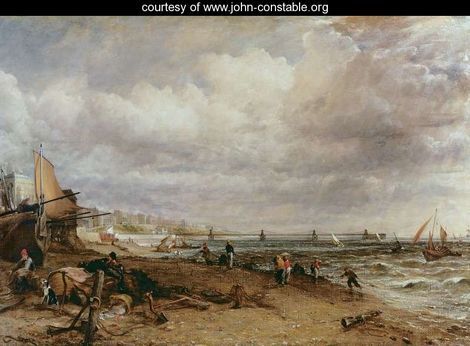
Marine Parade and Old Chain Pier, 1827 Painted by: John Constable Year: 1827
Constable had been reluctant to sell, although, as he said, “I need the money dreadfully.” As a conservative English patriot, a Whig, who had lived through twenty years of war with France, he had great anguish not thinking of the French as filthy, smelly Frogs of no moral pedigree. He also held the Englishman’s traditional view of Paris: “Think of the lovely valleys amid the peaceful farm houses of Suffolk forming a scene of exhibition to amuse the gay and frivolous Parisians!”
Amusement was hardly what “The Hay Wain” provided in Paris. Constable didn’t read French, but his wife translated the news for him. This staunch nationalist, borderline racist, could hardly believe it. He had an epiphany. “My landscapes have made an epoch there,” he wrote, “they wonder where the brightness comes from.” The commissions rolled in, and the critics raved wildly. Two pictures, “The Hay Wain” and “A View on the Stour”, were placed on special exhibit at the Louvre, and Charles X awarded him the Salon’s Gold Medal. Constable was overcome. “What a feather!” he exclaimed. It was the first official acknowledgment of his genius.
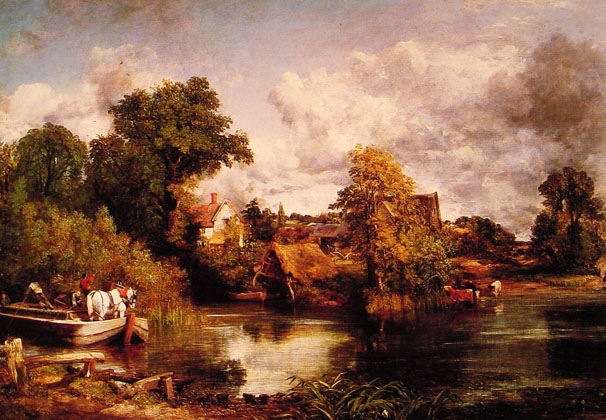
Constable. The White Horse. 1819. "Of Constable's color, Delacroix wrote in his journal: "What he says here about the green of his meadows can be applied to every tone". Delacroix repainted the background of his 1824 Massacre de Scio after seeing the Constables at Arrowsmith's Gallery, which he said had done him a great deal of good. In his lifetime Constable was to sell only twenty paintings in England, but in France he sold more than twenty in just a few years. Despite this, he refused all invitations to travel internationally to promote his work, writing to Francis Darby: "I would rather be a poor man (in England) than a rich man abroad." In 1825, perhaps due partly to the worry of his wife's ill-health, the lack of congeniality of living in Brighton ("Piccadilly by the Seaside"), and the pressure of numerous outstanding commissions, he quarreled with Arrowsmith and lost his French outlet."
No one knows why Constable quarreled with Arrowsmith, but suddenly, just when it seemed he might become a leader of European art, he flatly refused to let ” the French man” have any more pictures. Certainly, Constable disliked having to work on a commisioned basis. Commissions were “jobs” and having to do a job irritated him. Also, Arrowsmith seems to have been neither very generous nor very tactful, and one day, with the short temper for which he was notorious, Constable sent him a packing.
The break with France came at an unfortunate time. A few months later Constable finished the sixth and last painting in the “canal” series: “The Leaping Horse” ; his most dramatic canvas and a superb culmination to the group of paintings with which he made his bid for fame. Yet, “no one picture ever departed from my easel with more anxiety on my part,” Constable declared, and his premonitions were correct: The Academy, predictably, was outraged, and the painting was not sold.
Nor was “The Leaping Horse” shown in Paris. Nevertheless, twenty of Constable’s canvases had gone to france and there they forged a link in the chain that would result in an altogether new concept of art. Delacroix changed his palette because of them; a group of landscape painters working in the Forest of Fontainbleau was influenced by those brilliant East Anglian views, and the generation that followed the Barbizon School, as it was called, would make wonderful use of Constable’s discoveries. Would the Impressionist movement have been hurried forward had Millet, Corot and Delacroix seen “The Leaping Horse” or Constables oil sketches? The “ifs” surrounding Constable’s moment of glory in Paris have intrigued art historians ever since.
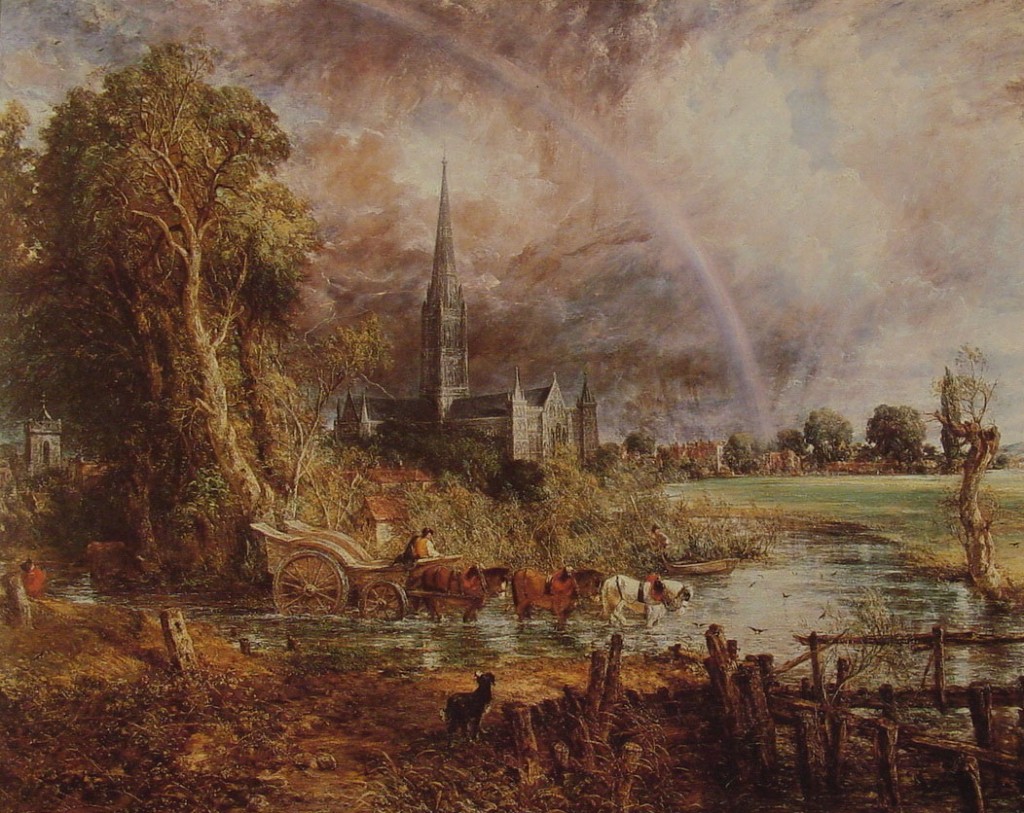
At John Fisher's home in Salisbury, Constable found not only encouragement after his wife's death but also a majestic subject for his art: Salisbury Cathedral. Constable included a rainbow, suggesting perhaps that his visit with Fisher had rekindled his hopes.
Constable was never again to know fame in his lifetime. As though even this brief success had to be tempered with disappointment, the first serious signs of Mrs. Constable’s tuberculosis emerged in 1824. They went to Brighton for her health, and while she rested he painted sea pictures, including “Brighton Beach, with Colliers” and “The marine parade and Chain Pier, Brighton”. Indeed, it was here that he heard of the sensation his work had created in Paris.
His wife’s illness, his increasingly large family, which numbered seven children by 1828, his problematic position with the Royal Academy, all contributed to a new seriousness in Constable. He worried about money. The collapse of agriculture after the Napoleonic Wars was ruining the prosperity of his beloved Stour valley, and it was a great shock to Constable, faithful believer in the old social order, to hear that the starving villagers of East Bergholt were rioting. The financial situation was sometimes so bad that the mill, a source of income for Constable, failed to make a profit.
Now and then there were hints of fame. Constable described one of them in a letter to a friend: “In the coache yesterday coming from Suffolk, were tow gentlemen and myself, all strangers to each other. In passing through the valley about Dedham, one of them remarked to me, on my saying that it was beautiful, “Yes, sir, this is Constable’s country!”


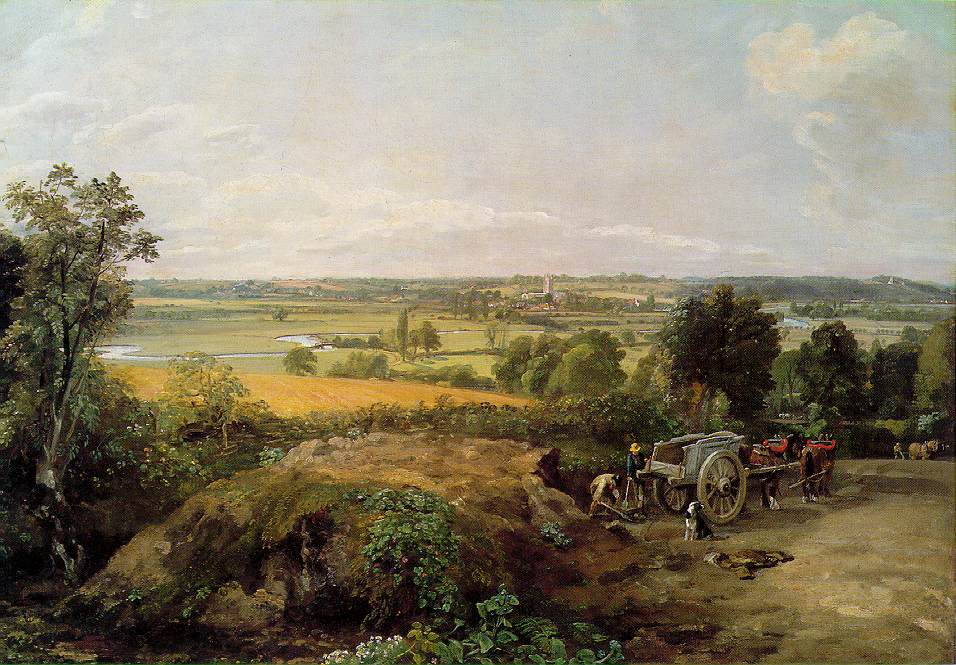

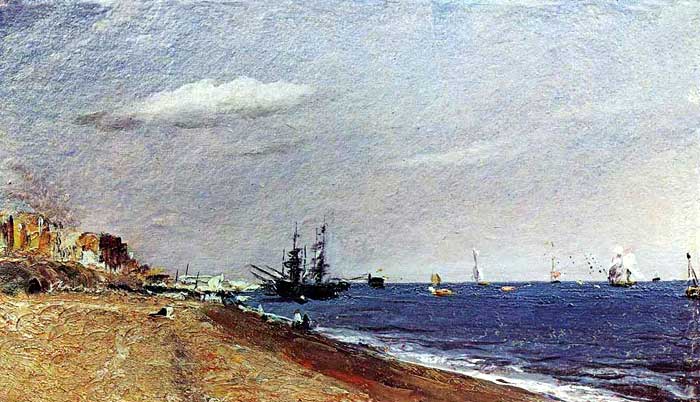




 COMMENTS
COMMENTS



